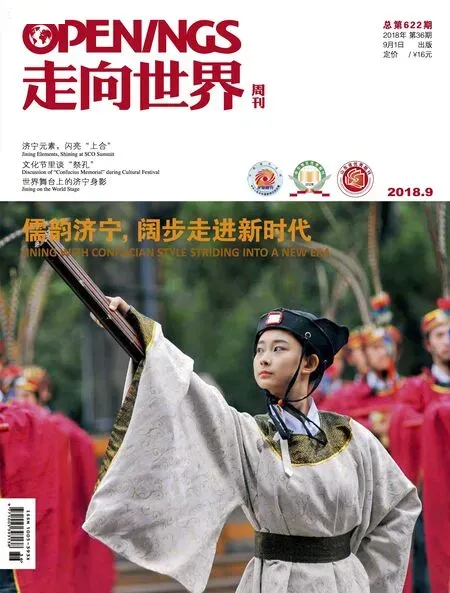天下汉碑半济宁
文/李取勉
济宁是中华儒家文化的发祥地,历史文化悠久,文物古迹众多,尤其是书法绘画艺术,令人叹为观止。
“天下汉碑半济宁”之说,指的是济宁地区拥有的汉碑数量为全国之最。据统计,济宁境内现存汉代碑刻有38种之多,占到全国汉碑存量的半数以上。“济宁汉画甲天下”,指济宁地区是中国汉画像石重点出产地,境内画像石达2000余石,数量之多,种类之全,不虚此名。碑刻承载着最真实、最坚固的文化艺术,集历史、文学、书法、镌刻于一体,是中华先人留给济宁人民乃至整个华夏民族的一笔巨大财富。

○济宁博物馆馆藏的汉碑。Stele of the Han Dynasty in Jining Museum.
俗话说“汉碑三字为宝”,年代愈久远愈有价值。立碑纪事源于汉代,汉字的成熟离不开汉隶的形成这一重要阶段。汉代“隶变”“八分”,使得汉字由初时篆体的圆转笔势发展为折笔方块字的隶书,由圆入方、由繁入简,为楷书的出现和流行奠定了基础。曲阜孔庙所藏的西汉《北陛刻石》《五凤刻石》,体现出汉字由篆入隶的发端;收藏于济宁市博物馆的西汉《禳盗刻石》,所刻字体是一种杂以篆意的古隶;曲阜孔庙所藏《乙瑛碑》《礼器碑》《史晨碑》可谓孔庙三大名碑,字体风格各异,为隶书成熟时期之代表。《乙瑛碑》之字体俊秀大气,“骨肉匀适,情文流畅”,是汉隶鼎盛时期的代表作品之一。《礼器碑》字体清劲秀雅,给人以肃穆超然之感,其笔画瘦硬刚健,收笔多方折,刀法粗壮,精美绝伦,为汉碑经典之作。《史晨碑》碑字结体方整,笔姿古厚朴实,端庄遒美,为汉碑之逸品。济宁市区北郊萧王庄东汉任城王墓的地宫壁石,单体刻石800多块、文字4000余字,铭刻内容大多为当时石工和送石者的地名和人名,按其隶字书风,集中向世人展现了汉代民间书法的独特风貌,有着很高的学术价值和艺术水平。

○东汉画像石拓片——孔子见老子(原石藏于济宁市博物馆汉碑室)。 图/胡冰Rubbing of the Stone Relief of the Eastern Han Dynasty – Confucius Meeting Laozi (the stone relief is collected in the Stone Tablet Room of Han, Jining Museum).
自北宋以来,学者著录、阐释济宁汉碑的文献不下数十种。历代书法家通过研习,提高了书艺。贯穿中国隶书产生、发展、演化全过程的济宁汉碑已被列为全国重点文物,它们就像一颗颗明珠在济宁这块具有丰厚人文积淀的沃土上熠熠闪光。
汉画像石是中华民族艺术宝库中的重要文化遗产,它充分体现出汉代时期的雕刻、绘画、建筑、装饰艺术和工艺设计等发展水平。汉画像石题材丰富多样,生动地描绘了汉代社会的典章制度、衣食住行、神话故事、风土人情,是当时社会生活的真实再现。汉画像石是汉代文化最具代表性的艺术作品。在艺术形式上,它上承战国绘画古朴之风,下开魏晋风度艺术之先河,奠定了中国画的基本法规和规范。汉画像石同商周的青铜器、南北朝的石窟艺术、唐诗、宋词一样,各领风骚数百年,成为中国文化艺术中的杰出代表和文化艺术瑰宝,是中华民族艺术宝库中璀璨的明珠。
汉画像石在全国以山东济宁发现最多。济宁汉画像石的艺术风格以质朴厚重见长,古风盎然。如济宁市博物馆画像石古拙朴素,极具抽象浪漫之美;邹城画像石夸张大胆,雕刻大刀阔斧、粗狂豪迈;微山画像石雄浑苍健,独具阳刚之美;嘉祥画像石精致细腻,线条流畅飞扬。前人有云:“唯汉代艺术,博大沉雄”,“唯汉人石刻,气魄深沉雄大”。
济宁汉画像石题材内容十分广泛,大致可以分为神话传说、历史故事和社会生活三类。神话传说类刻画了仙境人物(西王母、东王公、雷神、风伯、雨师、海神、伏羲、女娲等诸多神灵)、神禽异兽(龙、金蟾、玉兔、三足乌、九头人面兽等)的艺术形象,瑰丽而精彩;历史故事类内容丰富,最具代表性的有孔子见老子、周公辅成王、泗河捞鼎、季札挂剑、秋胡戏妻等;社会生活类描绘了汉代生活的诸多场景,涉及车马出行、人物谒见、汲水酿酒、庖厨宴饮、农耕纺织、围捕狩猎、乐舞百戏、武术格斗、军事战争、楼阙桥梁等,堪称反映汉代社会生活的“百科全书”。
编辑/刘岩

○东汉汉碑拓片——乙瑛碑(原石藏于曲阜汉魏碑刻馆)。 图/胡冰Stele Rubbing of the Eastern Han Dynasty – Stele of Yi Ying (the stone stele is collected in the Qufu Han and Wei Stele Exhibition Gallery).
Jining, as the birthplace of the Chinese Confucian culture, has a long history and culture, as well as numerous cultural relics and historic sites, ranking 1st in Shandong in this aspect. The reputations of the Hometown of Confucius and Mencius, the Land of Ceremonies and the Canal City are all shown on the stele inscriptions and stone reliefs of the Han Dynasty. The calligraphy and painting arts in Jining are especially amazing.
According to statistics, there are 38 types of extant stele inscriptions of the Han Dynasty in Jining, accounting for over a half of the stele inscriptions of the Han Dynasty nationwide. Jining is a major producing area of the stone reliefs of the Han Dynasty, and has more than 2,000 stone reliefs. The stele inscriptions carry the truest and strongest culture and art, which integrate history, literature, calligraphy and engraving, and have become the great treasure of the Jining people and the entire Chinese nation left by our Chinese ancestors.
Since the Northern Song Dynasty,scholars have composed dozens of historical documents to expound on the stele inscriptions of the Han Dynasty in Jining. Through study, the calligraphers of all ages have enriched and elevated the calligraphy art. The steles of the Han Dynasty in Jining running through the whole process of generation, development, and evolution of the Chinese official script have been protected as national key cultural heritage. Like bright pearls, they shine on the land with profound cultural deposits.

